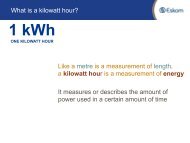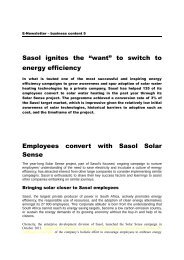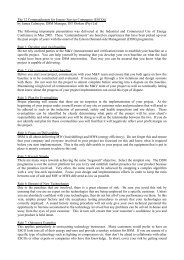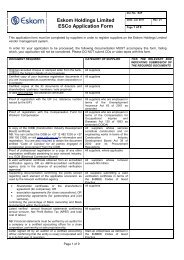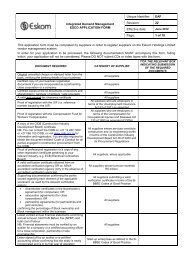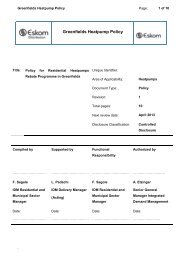Geyser facts sheet - Eskom IDM
Geyser facts sheet - Eskom IDM
Geyser facts sheet - Eskom IDM
You also want an ePaper? Increase the reach of your titles
YUMPU automatically turns print PDFs into web optimized ePapers that Google loves.
Switch off your geyser.<br />
The electricity demand it reduces helps the whole of South Africa.<br />
The residential sector uses about 17% of the total electricity generated in South Africa. From<br />
7am to 10am in the morning, and 5pm to 9pm in the evening – periods of peak demand in<br />
South Africa – residential demand is up to 35% of the total demand required.<br />
And the appliance most responsible?<br />
Domestic geysers are responsible for that sharp evening peak.<br />
One simple action is needed:<br />
• Switch it off during peak periods – it is one of the most<br />
effective ways to reduce pressure on the national grid. A<br />
timer is a simple device that can be installed to assist you<br />
to automatically switch your geyser element off during<br />
peak periods. The geyser timer will be set to switch off<br />
by default between 6am and 8am as well as 6pm and 8pm<br />
on weekdays. Consumers may also ensure they are off<br />
the grid during the evening peak by manually switching off<br />
their geysers from 5pm to 9pm, or at least a portion of<br />
that peak period.<br />
Here are some common myths about geysers<br />
and electricity supply:<br />
Myth: Switching off your geyser does not significantly reduce<br />
the overall peak demand for electricity.<br />
Fact: The nearly 5,4 million electric geysers<br />
in South Africa contribute about 2,940MW<br />
of electricity to the evening peak, enough<br />
to free-up five units of a ‘six-pack’ power<br />
station or power a big city the size of<br />
Durban.<br />
Myth:<br />
Fact:<br />
Myth:<br />
Switching a geyser off and on, uses more electricity than leaving it<br />
on permanently.<br />
“A geyser will not use more electricity if it is<br />
switched on and off. When a 150-litre geyser<br />
is switched off and stores its water at the<br />
thermostat set point, the water temperature<br />
decreases by approximately 10˚C over 24 hours<br />
(if no water is used during this period). This<br />
so-called ‘standing loss’ is a quality standard<br />
set by the South African Bureau of Standards<br />
(SABS). If the geyser is switched back on,<br />
electricity will be used to heat the water to<br />
its set point temperature. No saving will be<br />
achieved but the geyser will also not use more<br />
electricity than if it remained switched on,” says<br />
Kwikot Technical Director, Herman Weber.<br />
Switching a geyser off and on, damages the thermostat.<br />
Fact: “Switching a geyser off and on, or using a<br />
timer to do the switching, will not<br />
damage the unit. A thermostat, by the<br />
nature of its operation, switches a geyser<br />
off and on throughout the day,” says Weber.<br />
“The thermostat is designed to switch the<br />
element off and on continually which the<br />
timer will do,” says Richard da Silva,<br />
Instruments Manager at Hellermann Tyton.<br />
Myth: Switching a geyser off and on, could crack the geyser’s<br />
metal casing.<br />
Fact: Operating, as designed, a geyser cycles<br />
through a heat range far greater than the<br />
slow cooling of a geyser when it is switched<br />
off.<br />
Myth: If you cover a geyser with a ‘geyser blanket’ you don’t have<br />
to switch it off to save electricity.<br />
Fact: Switching geysers off does not save<br />
electricity, it assists <strong>Eskom</strong> to reduce the<br />
evening peak demand. <strong>Geyser</strong> blankets<br />
and water pipe insulation however will<br />
save small amounts of electricity. You still<br />
need to switch off your geyser over periods<br />
of peak demand to ease pressure on the<br />
national grid.<br />
Myth:<br />
A geyser covered with a ‘geyser blanket’ can overheat,<br />
explode or ignite.<br />
Fact: Provided the geyser blanket and water<br />
pipe insulation are manufactured from<br />
suitable material, there is no risk of fire or<br />
explosion. The blanket simply reduces<br />
heat loss, while the thermostat controls<br />
water temperature<br />
Myth:<br />
Fact:<br />
A geyser fitted with a timer offers a more efficient way to manage<br />
electricity demand during peak periods.<br />
The results are identical, whether you use a timer<br />
or switch the geyser off manually. Note that<br />
switching your geyser off does not save you<br />
energy but keeps you off the grid during <strong>Eskom</strong>’s<br />
critical peak periods, that is especially required<br />
during the evening peak.
• Insulate your geyser and water pipes. <strong>Geyser</strong> blankets and<br />
pipe insulation reduce the cooling rate of a geyser when<br />
switched off, and the electricity needed to reheat the water.<br />
This measure could save an average household of four,<br />
between R180 and R250 annually.<br />
• Set your geyser’s thermostat at 60˚C.<br />
• Switch off your geyser before going on holiday or an extended<br />
trip, switching off for long periods will produce savings on<br />
your bill.<br />
• Install your geyser close to the tap outlet where the water is<br />
to be used.<br />
• Use cold water for washing your hands.<br />
• Install an energy and water saving shower head. You could<br />
reduce your energy consumption by up to 16%, and your hot<br />
water usage by up to 24%.<br />
• A seven-minute shower is more efficient than running a full<br />
bath.<br />
• Don’t run hot water freely and unnecessarily, use a basin plug.<br />
• If your clothes are not particularly dirty, skip the pre-wash<br />
cycle on your washing machine. This could save up to 20%<br />
of the electricity needed to heat the water in the washing<br />
machine.<br />
• Wash bed linen at 60˚C instead of 90˚C, and always wash a<br />
full load.<br />
• Fill your dishwasher, turn it off at the drying cycle, and dry the<br />
dishes by hand.<br />
• Connect the dishwasher to the cold water supply when<br />
cleaning the filters.<br />
Remember<br />
Consider replacing your electric element geyser with a heat pump<br />
or a solar water heating system, as an energy-efficient solution to<br />
heating water in your home. <strong>Eskom</strong> currently offers rebates on<br />
both heat pumps and solar systems.<br />
Let’s be energy-smart<br />
<strong>Eskom</strong> invites the homeowner to partner with it in a national<br />
drive to become electricity smart and adopt energy-efficient<br />
habits and practice. Together, let’s save electricity and ensure an<br />
environmentally friendlier South Africa.<br />
Measures to reduce your electricity bill and save<br />
money<br />
Not all changes in behaviour will result in your monthly electricity<br />
bill being reduced. Some behaviours like manually switching off<br />
your geyser and pool pump, or having a timer installed to do<br />
this for you automatically, will help you to help <strong>Eskom</strong> keep the<br />
power supply stable. However, the combination of easy measures<br />
mentioned here can help you reduce the cost component of<br />
heating water which, in an average household, represents between<br />
30% and 50% of your total electricity bill.<br />
Information supplied by:<br />
<strong>Eskom</strong>, Kwikot, Franke Water Heating Systems and Hellermann<br />
Tyton<br />
Visit www.eskom.co.za/idm for more information on the energy<br />
efficiency rebate programmes available to homeowners.<br />
<strong>Eskom</strong> Holdings SOC Limited Reg No 2002/015527/06<br />
1923- 2013




